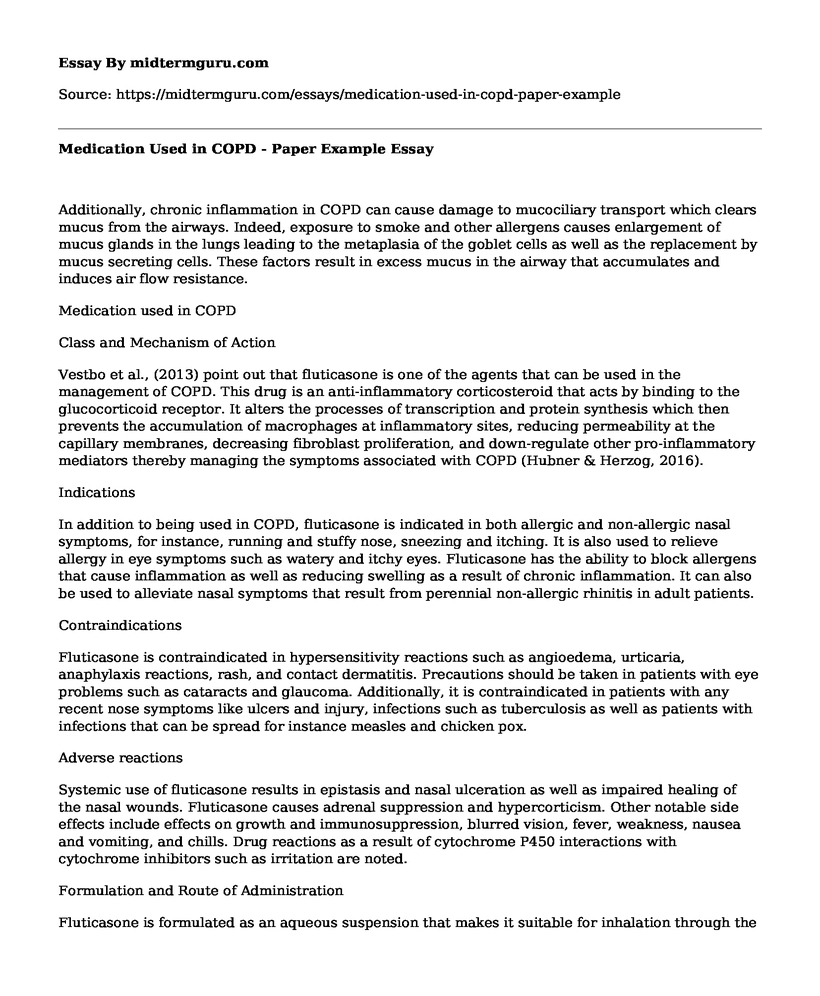Additionally, chronic inflammation in COPD can cause damage to mucociliary transport which clears mucus from the airways. Indeed, exposure to smoke and other allergens causes enlargement of mucus glands in the lungs leading to the metaplasia of the goblet cells as well as the replacement by mucus secreting cells. These factors result in excess mucus in the airway that accumulates and induces air flow resistance.
Medication used in COPD
Class and Mechanism of Action
Vestbo et al., (2013) point out that fluticasone is one of the agents that can be used in the management of COPD. This drug is an anti-inflammatory corticosteroid that acts by binding to the glucocorticoid receptor. It alters the processes of transcription and protein synthesis which then prevents the accumulation of macrophages at inflammatory sites, reducing permeability at the capillary membranes, decreasing fibroblast proliferation, and down-regulate other pro-inflammatory mediators thereby managing the symptoms associated with COPD (Hubner & Herzog, 2016).
Indications
In addition to being used in COPD, fluticasone is indicated in both allergic and non-allergic nasal symptoms, for instance, running and stuffy nose, sneezing and itching. It is also used to relieve allergy in eye symptoms such as watery and itchy eyes. Fluticasone has the ability to block allergens that cause inflammation as well as reducing swelling as a result of chronic inflammation. It can also be used to alleviate nasal symptoms that result from perennial non-allergic rhinitis in adult patients.
Contraindications
Fluticasone is contraindicated in hypersensitivity reactions such as angioedema, urticaria, anaphylaxis reactions, rash, and contact dermatitis. Precautions should be taken in patients with eye problems such as cataracts and glaucoma. Additionally, it is contraindicated in patients with any recent nose symptoms like ulcers and injury, infections such as tuberculosis as well as patients with infections that can be spread for instance measles and chicken pox.
Adverse reactions
Systemic use of fluticasone results in epistasis and nasal ulceration as well as impaired healing of the nasal wounds. Fluticasone causes adrenal suppression and hypercorticism. Other notable side effects include effects on growth and immunosuppression, blurred vision, fever, weakness, nausea and vomiting, and chills. Drug reactions as a result of cytochrome P450 interactions with cytochrome inhibitors such as irritation are noted.
Formulation and Route of Administration
Fluticasone is formulated as an aqueous suspension that makes it suitable for inhalation through the intranasal route. It is formulated as nasal drops or dry powder for inhalation through the nasal route. It is conjugated using a propionate ester to increase bioavailability and efficacy as well as a long therapeutic effect. The mode of administration is intranasal route.
References
Des Jardins, T., & Burton, G. G. (2015). Clinical Manifestations & Assessment of Respiratory Disease. Elsevier Health Sciences.
Hubner, R. H., & Herzog, D. (2016). COPD treatment: about collateral channels and collapsing airways. European Respiratory Journal, 47(6), 1606-1610.
Vestbo, J., Hurd, S. S., Agusti, A. G., Jones, P. W., Vogelmeier, C., Anzueto, A., ... & Stockley, R. A. (2013). Global strategy for the diagnosis, management, and prevention of chronic obstructive pulmonary disease: GOLD executive summary. American journal of respiratory and critical care medicine, 187(4), 347-365.
Cite this page
Medication Used in COPD - Paper Example. (2021, Jun 08). Retrieved from https://midtermguru.com/essays/medication-used-in-copd-paper-example
If you are the original author of this essay and no longer wish to have it published on the midtermguru.com website, please click below to request its removal:
- Essay on Predicting Hospital Readmission Risk
- Stop HIV/AIDS Background: Vision and Goals of the Program
- Essay on Lifestyle Diseases
- Nursing in US: Challenges in Leadership, Practice, and Training - Essay Sample
- Sciatic Nerve: Causes & Symptoms of Sciatica Pain - Essay Sample
- Telehealth and the Role of Nurses in Strengthening Healthcare Infrastructure - Essay Sample
- Clinician's Unique Skill: Understanding Patient Goals & Prognosis - Essay Sample







